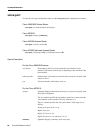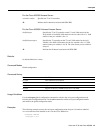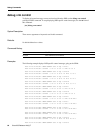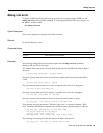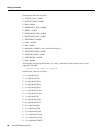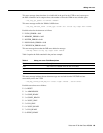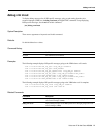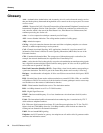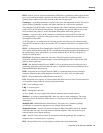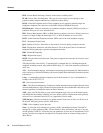
Glossary
74
Cisco IOS Release 12.0(7)T
PBX—Private Branch Exchange. Privately-owned central switching office.
PLAR—Private Line Auto Ringdown. This type of service results in a call attempt to some
particular remote endpoint when the local extension is taken off-key.
POTS—Plain Old Telephone Service. Basic telephone service supplying standard single line
telephones, telephone lines, and access to the Public Switched Telephone Network.
POTS dial peer—Dial peer connected via a traditional telephony network. POTS peers point to a
particular voice-port on a voice network device.
PRI—Primary Rate Interface. PRI is an ISDN interface to primary rate access. Primary rate access
consists of a single 64 Kbps D channel plus 23 T1 or 30 E1 B channels for voice or data.
PSTN—Public Switched Telephone Network. PSTN refers to the local telephone company.
PVC—Permanent Virtual Circuit.
QoS—Quality of Service, which refers to the measure of service quality provided to the user.
RAS—Registration, Admission, and Status Protocol. This is the protocol that is used between
endpoints and the gatekeeper to perform management functions.
RBS—Robbed Bit Signaling
RRQ—Registration request.
RSVP—Resource Reservation Protocol. This protocol supports the reservation of resources across
an IP network.
T1—Digital WAN carrier facility. T1 transmits DS-1 formatted data at 1.544 Mbps through the
telephone-switching network, using AMI or B8ZS coding. T1 is the North American equivalent of
an E1 line.
TCL—Tool Command Language. An interpreted script language developed by Dr. John Ousterhout
of the University of California, Berkeley, and now developed and maintained by Sun Microsystems
Laboratories.
U-law—A companding technique commonly used in North America. U-law is standardized as a
64-Kbps codec in ITU-T G.711.
SPI—Service provider interface.
TDM—Time division multiplexing. Technique in which information from multiple channels can be
allocated bandwidth on a single wire based on preassigned time slots. Bandwidth is allocated to each
channel regardless of whether the station has data to transmit.
VoIP—Voice over IP. The ability to carry normal telephone-style voice over an IP-based internet
with POTS-like functionality, reliability, and voice quality. VoIP is a blanket term which generally
refers to Cisco’s standards based (H.323, etc.) approach to IP voice traffic.
VoIP dial peer—Dial peer connected via a packet network; in the case of Voice over IP, this is an
IP network. VoIP peers point to specific VoIP devices.
VTSP—Voice telephony service provider.
Zone—A collection of all terminals (tx), gateways (GW), and Multipoint Control Units (MCU)
managed by a single gatekeeper (GK). A Zone includes at least one terminal, and may or may not
include gateways or MCUs. A Zone has only one gatekeeper. A Zone may be independent of LAN
topology and may be comprised of multiple LAN segments which are connected using routes or
other devices.




